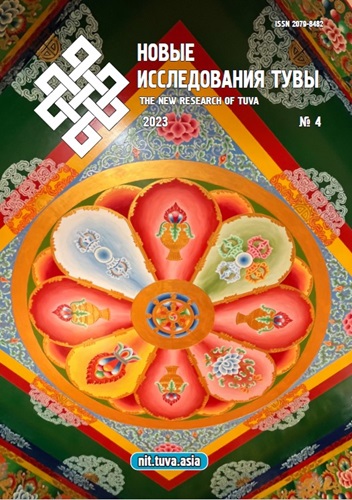Comparative analysis of phraseological units with somatism hand as a way of linguocultural competence formation (on the material of Russian, Kazakh, Tuvan and English languages)
DOI:
https://doi.org/10.25178/nit.2023.4.8Keywords:
phraseology; linguocultural competence; teaching methodology; ethnocultural studies; language didactics; archetypes of linguistic consciousness; Kazakh language; Tuvan language; Russian language; English languageAbstract
The article delves into the potential avenues for cultivating linguistic and cultural competence through the study of phraseology. A comparative analysis of phraseological units incorporating the somatic component ‘hand’ in Tuvan, Kazakh, Russian, and English languages is presented as a method to implement the integrative teaching principle. The authors posit that phraseology in any language vividly mirrors the archetypal consciousness of the ethnic group and the distinctive metaphorical representation of objects in the surrounding world. This stimulates the ethnolinguistic curiosity of learners, initiates their multilingual training, and underscores the significance of mastering phraseology from a linguistic and cultural perspective, including the comparative aspect.
The research material comprises phraseological units featuring the somatic component ‘hand’, systematically selected from the respective phraseological dictionaries of the languages under examination. The study aims to develop integrative methodologies for fostering linguistic and cultural competence among learners, grounded in an understanding of the ethnocultural connotations of somatic phraseology, which reflect specific ways of conceptualizing the surrounding reality.
The study outlines various research and pedagogical methods (comparative, explanatory-illustrative, linguistic-semantic, exploratory, etc.) and techniques (consulting dictionaries, analyzing communicative speech acts, constructing Venn diagrams, etc.). The research findings reveal that despite the anticipated universal cognitive understanding of human anatomy across cultures, the perception of a culturally identical object — the human body — varies significantly. When comparing phraseological units incorporating the somatic element ‘hand’, both shared (cross-cultural) and culture-specific models of perception emerge. These models elucidate the patterns of figurative interpretation of worldly phenomena and specify the conceptualization of ideas concerning the human somatic domain in diverse cultural contexts.
References
Beliaevskaia, E. G. and Maliar, T. N. (2011) Printsipy minimizatsii interferentsii rodnogo iazyka pri obuchenii inostrannomu iazyku (kontseptual'nye struktury prostranstva i vremeni v angliiskom i russkom iazykakh) [Principles of minimizing interference of the native language in teaching a foreign language (conceptual structures of space and time in English and Russian)]. Moscow, IPK MGLU «Rema». 180 p. (In Russ.).
Gal'skova, N. D. and Gez, N. I. (2004) Teoriia obucheniia inostrannym iazykam. Lingvodidaktika i metodika [Theory of teaching foreign languages. Linguodidactics and methodology]. Moscow, Akademiia. 256 p. (In Russ.).
Dmitriuk, N. V. (2009) Frazeologicheskii somatikon kak otrazhenie arkhetipov iazykovogo soznaniia etnosa [Phraseological Somaticon as a reflection of the archetypes of the linguistic consciousness of an ethnic group]. Voprosy psikholingvistiki, no. 10, pp. 30–34. (In Russ.).
Dmitriuk, N. V. (2012) Yazykovoe soznanie: lingvokul'turologicheskie issledovaniia [Linguistic consciousness: linguistic and cultural studies]. Saarbrücken, Palmarium Academic Publishing. Germany. 238 p. (In Russ.).
Zalevskaia, A. A. (2010) Voprosy teorii i praktiki issledovaniia dvuiazychiia [Questions of theory and practice of bilingualism research]. In: Yazykovoe bytie cheloveka i etnosa: Kognitivnye i psikholingvisticheskie aspekty [Linguistic existence of a person and an ethnic group: Cognitive and psycholinguistic aspects] / ed. by V. A. Pishchal'nikova. Moscow, INION RAN; ASOU. Issue 16. VI Berezenskie chteniia. 276 p. Pp. 63–69. (In Russ.).
Kechil-ool, S. V. and Saaia, O. M. (2016) Osobennosti frazeologizmov s komponentom «ukho» v tuvinskom iazyke v sopostavlenii s russkim [Phraseological units with the component “Ear” in the Tuvan language in comparison with the Russian]. Philology. Theory & Practice, no. 9–2(63), pp. 107–109. (In Russ.).
Kechil-ool, S. V. and Saaia, O. M. (2017) Semanticheskie osobennosti frazeologizmov s komponentom «ruka» v tuvinskom i russkom iazykakh [The semantic peculiarities of phraseological units with the component “Hand” in the Tuvan and Russian languages]. Philology. Theory & Practice, no. 6–1(72), pp. 92–95. (In Russ.).
Kechil-ool, S. V., Saaia, O. M. (2021) Frazeologizmy s komponentom churek «serdtse» v tuvinskom i v russkom iazykakh [Phraseological units with chүurek ‘heart’ in Tuvan and Russian]. Mir nauki, kul'tury, obrazovaniia, no. 5 (90), pp. 344–346. (In Russ.). DOI: www.doi.org/10.24412/1991-5497-2021-590-344-346
Kunanbaeva, S. S. (2010) Teoriia i praktika sovremennogo inoiazychnogo obrazovaniia [Theory and practice of modern foreign language education]. Almaty, DP Edel'veis; Kazakhskii universitet mezhdunarodnykh otnoshenii i mirovykh iazykov. 344 p. (In Russ.).
Lamazhaa, Ch. K. (2023) Concepts of Culture: Form, idea, social regulation [Kontsepty kul’tury: forma, ideia, sotsial’naia reguliatsiia]. New Research of Tuva, no. 1, pp. 6–25. (In Russ.). DOI: https://doi.org/10.25178/nit.2023.1.1
Lamazhaa, Ch. K., Kuzhuget, Sh. Yu. and Mongush, A. V. (2022) Khoi e"di dlia tuvintsev. Identichnost', udobstvo, otvetstvennost' [Khoi edi for Tuvans. Identity, convenience, responsibilityz]. Etnografiia, no. 4 (18), pp. 151–174. (In Russ.). DOI: https://doi.org/10.31250/2618-8600-2022-4(18)-151-174
Moskvitheva, S. A., Aleksandrova, O. I. and Ebzeeva, Yu. N. (2022) Fol'klornye kul'turemy i struktura kul'turnykh reprezentatsii tuvintsev [Folklore culturemes in the structure of cultural representations of Tuvan people]. New Research of Tuva, no. 1, pp. 164–182. DOI: https://doi.org/10.25178/nit.2022.1.11
Rakhimzhanov, K. Kh., Akosheva, M. K. and Temirgazina, Z. K. (2020) Metaforichesko-metonimicheskaia interpretatsiia serdtsa v kazakhskom i tuvinskom iazykakh: vzaimodeistvie iazyka, anatomii i kul'tury [Metaphorical and metonymical interpretation of the heart in the Kazakh and Tuvan languages: an interaction of language, anatomy and culture]. New Research of Tuva, no. 4, pp. 261–271. (In Russ.). DOI: https://doi.org/10.25178/nit.2020.4.18
Saaia, M., Dambyra, I. D., Kechil-ool, S. V. (2020) Osobennosti frazeologicheskikh edinits s komponentom «iazyk» v russkom i tuvinskom iazykakh v sopostavitel'nom aspekte [Features of phraseological units with the component “language” in the Russian and Tuvan languages in a comparative aspect]. Mir nauki, kul'tury, obrazovaniia, no. 6 (85), pp. 596–599. (In Russ.). DOI: https://doi.org/10.24412/1991-5500-2020-685-596-599
Sorokin, Yu. A. (1998) Antropotsentrizm vs antropofiliia: dovody v pol'zu vtorogo poniatiia [Anthropocentrism vs anthropophilia: arguments in favor of the second concept]. In: Yazyk, soznanie, kommunikatsiia [Language, consciousness, communication] / ed. by V. V. Krasnykh and A. I. Izotov. Issue 4. Moscow, Filologiia. 128 p. Pp. 34–44. (In Russ.).
Chertykova, M. D. (2018) Somaticheskie frazeologizmy kak sfera soprikosnoveniia tiurkskogo mirovideniia: komponent «serdtse» [Somatic phraseological units as a sphere of contact of the Turkic worldview: the "heart" component]. Mir nauki, kul'tury, obrazovaniia, no. 3 (70), pp. 344–346. (In Russ.).
Al Asadi, S. S. (2020) Intercultural Awareness and Writing through the Use of WebQuest: Iraqi Students at AlAwsat Technical University as a Case Study. Arab World English Journal (AWEJ) Special Issue on CALL, no. 6, pp. 379–393. (In Russ.). DOI: https://dx.doi.org/10.24093/awej/call6.25
Alyeksyeyeva, I., Chaiuk, T., Kovalchuk, I. and Galitska, E. (2022) Making Sense of Texts: EFL Students’ Intercultural Competence and Interpretation Depth. Arab World English Journal, no. 13 (1), pp. 104–116. (In Russ.). DOI: https://dx.doi.org/10.24093/awej/vol13no1.7
Byram, M. (1997) Teaching and Assessing Intercultural Communicative Competence. Clevedon, UK., Multilingual Matters. 124 p.
Chomsky, N. (1965) Aspects of the Theory of Syntax. Cambridge, MA., MIT Press. 251 p.
Cooper, Th. C. (1998) Teaching idioms. Foreign Language Annals, vol. 31, issue 2, pp. 255–266. DOI: https://doi.org/10.1111/j.1944-9720.1998.tb00572.x
Hymes, D. H. (1972) On Communicative Competence. In: Pride J. B., Holmes J. (eds) Sociolinguistics: Selected Readings. Harmondsworth: Penguin. 381 p. Pp. 269–293.
Lennon, P. (1998) Approaches to the teaching of idiomatic language. IRAL, vol. 36, pp. 11–30.
Ferrara, R. (2018) Teaching vocabulary Focus Education. Ltd Publishing. 94 p.
Venn, J. M. A. (1880) I. On the diagrammatic and mechanical representation of propositions and reasonings. Philosophical Magazine Series, series 5, vol. 10, issue 59, pp. 1–18. DOI: http://dx.doi.org/10.1080/14786448008626877
Published
How to Cite
For citation:
Mambetova G. T., Shingareva M. Yu., Dmitryuk N. V. and Stycheva O. A. Sopostavitel’nyi analiz frazeologicheskikh edinits s somatizmom ruka kak sposob formirovaniia lingvokul’turnoi kompetentsii (na materiale russkogo, kazakhskogo, tuvinskogo i angliiskogo iazykov) [Comparative analysis of phraseological units with somatism hand as a way of linguocultural competence formation (on the material of Russian, Kazakh, Tuvan and English languages)]. New Research of Tuva, 2023, no. 4, pp. 109-123. DOI: https://doi.org/10.25178/nit.2023.4.8
Issue
Section

This work is licensed under a Creative Commons Attribution-NonCommercial 4.0 International License.

Author(s) license holder(s) grant rights for their work to the journal (grantee of a license) under the simple non-exclusive open license in accordance with Art. 1286.1 «Open license for a research work, work of literature or fine arts», Civil Code of the Russian Federation.
New Research of Tuva publishes articles under the Creative Commons Attribution-NonCommercial license (CC BY-NC).
Since it is an open license, author(s) reserve the right to upload the article to their institutional repository, submit it to another journal (if it allows republications), or republish it on their own website (in full, or in part).
However, several conditions apply here:
a) The republished version must always contain the name(s) and affiliation(s) of the author(s), the original title and the hyperlink to the original version on the New Research of Tuva website;
b) It must be in open access, free of charge, and no category of readers must be in any way whatsoever advantaged over general readership.
c) should the contribution be submitted elsewhere by its author(s) without substantial modification (30% or more of original text unchanged), the body of the article should contain a disclaimer that the original version was published in New Research of Tuva (with a link to the respective page)
The CC-BY-NC is a non-revocable license which applies worldwide and lasts for the duration of the work’s copyright.












